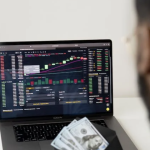In the world of forex trading, volatility is the heartbeat of the market. It’s the dynamic force that propels currencies through their highs and lows, presenting both opportunities and challenges for traders. To master the art of forex trading, understanding volatility is crucial. In this article, we’ll unravel the complexities of market volatility, explore its causes, and equip you with strategies to navigate its ever-changing currents. Whether you’re a seasoned trader or just setting sail in the forex waters, join us on this voyage of discovery.
What is Volatility in Forex Trading?
Volatility is the lifeblood of the forex market, epitomizing the price fluctuations of currencies over time. It’s the heartbeat that breathes life into trading charts and indicators. Imagine volatility as the energetic dance between a currency’s opening and closing prices within a specific timeframe.
To paint a clearer picture, let’s consider two currency pairs: one fluctuating modestly between 5-10 pips, and another exhibiting more vigorous movement within the range of 50-100 pips. The former is characterized by lower volatility, while the latter showcases higher volatility. This fluctuation is influenced by a multitude of factors, each contributing to the currency’s vitality.
The Dance of Volatility: Safe Havens and Exotics
Not all currencies sway to the same rhythm. Some currencies glide gracefully, while others perform intricate pirouettes. Take, for instance, the concept of ‘safe haven’ currencies. These stalwarts of stability, such as the Japanese Yen, Swiss Franc, and the US Dollar (to a certain extent), are known for their low volatility. Investors often seek refuge in these currencies during times of uncertainty, contributing to their steadfast nature.
In contrast, emerging market and exotic currencies, like the Turkish Lira, Mexican Peso, Indian Rupee, and Thai Baht, embrace higher volatility. Their spirited dance is a reflection of their susceptibility to external influences and market dynamics. These currencies, while offering potential for high returns, also come with an elevated level of risk.
Unraveling the Dance: Market Liquidity and Volatility
Picture yourself in a bustling market square, bartering for goods. Liquidity in forex is akin to the ease with which you can buy or sell those goods. High liquidity implies effortless transactions, while low liquidity results in a more cumbersome process.
Liquidity is a pivotal component of the volatility dance. Highly liquid instruments, like the EUR/USD, offer seamless trading experiences, even for substantial trades. However, be mindful of timing, as liquidity can wane during specific trading sessions, potentially impacting execution quality.
Intriguingly, a direct correlation exists between liquidity and volatility. Instruments abundant in liquidity generally exhibit lower volatility. Conversely, less liquid instruments, such as emerging market currencies, possess a higher propensity for volatility due to the ease with which they can be influenced.
The Essence of Volatility: A Necessary Ingredient
Warren Buffett eloquently stated, “All time is uncertain. It was uncertain back in 2007, we just didn’t know it was uncertain.” These words encapsulate the essence of volatility in trading. Uncertainty, ebb, and flow—all are integral to the world of forex.

Volatility is the lifeblood that fuels trading activity. Without it, markets would stagnate, and trading would grind to a halt. However, the challenge arises when volatility escalates to extreme levels. As a trader, striking the delicate balance between manageable volatility and tumultuous upheaval is paramount.
In this intricate dance of risk and reward, understanding the nature of volatility equips traders with the insight to navigate uncertain waters. Just as a ship captain relies on the tides to chart a course, traders harness volatility to set their sails.
Curtains Up: Unveiling the Catalysts of Market Volatility
The theater of forex is not without its drama, and the stage is set by a myriad of factors. Let’s pull back the curtain and reveal some of the key catalysts that stir the volatility pot:
1. Geopolitical Factors:
- Wars, uprisings, and civil unrest introduce uncertainty, resulting in market volatility.
- Extended periods of instability dampen traders’ sentiment and impact the market’s overall health.
2. Trade Wars:
- Global trade conflicts, such as those between the US and China, can trigger significant market volatility.
- The ripple effect of trade wars reverberates through currencies involved, influencing their trajectories.
3. Monetary Policies:
- Central banks hold the reins of economic stability through interest rate adjustments.
- Decisions by major central banks—such as the US Federal Reserve, European Central Bank, and others—can spark market volatility.
4. Trader and Market Sentiment:
- Traders and investors shape market movements, ushering in periods of optimism or pessimism.
- Sentiment-driven volatility is a reflection of the collective psyche of market participants.
5. Economic Indicators:
- High-impact economic events, like employment data or GDP releases, can disrupt market equilibrium.
- Anticipating and reacting to such events is essential for traders navigating the volatility landscape.
Currencies That Dance to Their Own Beat: Most Volatile Pairs
Within the intricate choreography of forex, certain currency pairs command attention for their captivating volatility. Let’s spotlight a few of these captivating performers:

1. AUD/JPY: The Risk Barometer
- The AUD/JPY pair acts as a risk barometer.
- The Australian Dollar’s risk-on persona collides with the Japanese Yen’s safe-haven allure, driving volatility.
- AUD/JPY rises during risk-seeking periods and falls when markets turn risk-averse.
2. GBP/CAD: The Oil-Infused Duo
- GBP/CAD boasts noteworthy volatility, influenced by both currencies’ unique dynamics.
- The British Pound is prone to fluctuation, while the Canadian Dollar dances to the tune of oil prices.
- Market sentiment, coupled with the ebb and flow of crude oil, fuels GBP/CAD’s dramatic performances.
3. USD/TRY: The Political Enigma
- The Turkish Lira (TRY) boasts a reputation for wild price swings, influenced by geopolitics and domestic policies.
- Political instability and the unpredictability of the central bank contribute to USD/TRY’s spirited dance.
Strategies for Navigating Volatility
As you embark on your journey through the forex seas, equip yourself with strategies to harness volatility’s power:
1. Embrace Stop Loss Orders:
- Set stop loss levels to shield yourself from market turbulence.
- These orders serve as safety nets, guarding against unexpected price swings.
2. Master the Economic Calendar:
- Monitor major economic events and decisions that impact markets.
- An informed trader is better positioned to anticipate and manage volatility.
3. Prudent Leverage Management:
- Leverage amplifies both gains and losses.
- By exercising caution and limiting leverage, you mitigate risk and enhance control.
4. Volatility Indicators:
- Utilize technical indicators to analyze market volatility.
- The Average True Range (ATR) indicator offers insights into price fluctuations.
Smooth Sailing: Navigating Volatility with Confidence
The forex market’s heartbeat is volatility—a pulse that courses through charts, indicators, and trading strategies. With a keen understanding of its nature and a strategic approach, you can harness volatility’s power to your advantage




